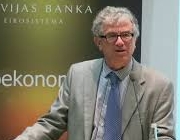Flexible exchange rates help developing countries cope with volatile prices of the commodities that are typically their main exports; but the lack of a currency peg leaves the economy without an anchor for monetary policy. This column proposes an alternative exchange rate regime: a ‘currency-plus-commodity basket’, which pegs the currency to a basket including not only the currencies of major trading partners but also the key export commodities. The goal is to achieve the best of both flexible and fixed exchange rates.
Since the turn of the century, countries that specialize in oil, minerals, and agricultural commodities have been hit by especially high volatility in world prices for their exports. Big price upswings (2004–08 and 2010–12) have alternated with reversals (2008–09 and 2014–16).
The volatility in export prices is one of a number of possible causes underlying the famous “natural resource curse”. In Frankel, 2012, I survey this “curse” and some possible responses to it. In Frankel (2018), I propose a new exchange rate regime for commodity-exporting countries in which the currency is pegged to a basket that includes commodities along with currencies.
An economist might be tempted to ask: Where is the market failure with commodity price volatility? Where is the need for a government policy? One answer is that financial markets in practice seem unable to fulfill the role of smoothing over time that theory asks of them. If anything, capital flows to commodity-exporting developing countries tend to be pro-cyclical rather than counter-cyclical, perhaps because creditors want collateral in the form of foreign exchange earned by commodity exports.
Another answer is that “laissez-faire” is not an option when it comes to monetary policy; a belief in free markets is not enough to tell the authorities whether to fix the exchange rate or to float freely.
An old piece of conventional wisdom says that terms-of-trade volatility, other things being equal, makes a country less suited to a currency peg and more suited to a flexible exchange rate regime that allows the exchange rate to accommodate terms-of-trade shocks.
A fixed exchange rate can render monetary policy pro-cyclical: Commodity booms are associated with money inflows, rapid credit expansion, an overheated real economy, inflation in non-traded goods and services, and bubbles in real estate and other assets. Conversely, commodity busts are associated with balance-of-payments deficits, loss of reserves, credit shortage, recession, and currency or financial crises.
Flexible exchange rates allow accommodation of trade shocks and therefore a counter-cyclical monetary policy. Under free-floating exchange rates, when the global price of the export commodity rises, threatening overheating, the currency automatically appreciates to mitigate the problem. When the global price of the export commodity falls, threatening external balance difficulties and recession, the currency automatically depreciates to mitigate those problems.
Empirical research seems to support the textbook generalization that exporters of commodities with volatile prices do better under floating rates than fixed rates. Examples include Broda (2004), Edwards and Levy-Yeyati (2005), Rafiq (2011), and Céspedes and Velasco (2012). Céspedes and Velasco, for example, look across 107 major-country commodity boom-bust cycles and find that the more flexible the exchange rate, the smaller the output loss from a given price decline.
On the other hand, a currency peg does have advantages of its own. It offers day-to-day transparency and predictability, and an anchor to make central bank promises of price stability credible. Such credibility is particularly needed among developing countries. If the exchange rate is not to be the anchor for monetary policy, what is?
Consider an alternative exchange rate regime (Frankel, 2008), which I call a “currency-plus-commodity basket (CCB). It is particularly relevant for countries like Kuwait that currently target a basket of major currencies such as the dollar and the euro. The CCB proposal adds the export commodity to the currency basket. If the Kuwaiti dinar were pegged to a basket that gave one-third weight to the dollar, one-third to the euro, and one-third to oil, the value of the currency would again automatically move up and down with the value of a barrel of oil.
Among Gulf countries, swings in both external balance and internal balance during 2001–16 can be attributed to the inability of their exchange rates to adjust to the ups and downs in oil prices in a way that the CCB proposal would have delivered automatically (Frankel, 2018). The argument in favor of a CCB, for a commodity-exporting country, is that it delivers the best of floating together with the best of fixed rates: automatic accommodation of trade shocks, together with a stable and transparent anchor.






